Japanese Lessons
Hirigana is the original alphabet that Japanese use, simplified by women who wrote letters and those involved in the literary field. Before hirigana was called "Women's Hand" because of this.
Learning Hirigana will take some study time and memorization on the part of the student. Nothing I can do will permanently put all these letters in your brain, that is up to you. Generally when writing Japanese letters, you put in the horizontal lines from top to bottom first, and then right the vertical lines from left to right.

The first letter, on the left side, is 'a'. This is pronounced the same as in 'dawn', or you can just think of the exclamation 'Ah!'. Remember that in Japanese, unlike English, each sound takes the same amount of length. The only time this doesn't happen is when there are long vowels or other certain characters, which I'll describe later.
The second letter is 'e'. This is pronounced like the 'a' in 'cane', or 'bane'.
The third letter is 'i'. This is pronounced like the 'e' in 'me'.
The fourth is 'o'. It is said like the 'o' in 'go'.
A lastly, the fifth is 'u'. This is pronounced like in 'moo' or 'zoo'. Remember that Japanese is consistant, unlike English. Every other letter will follow this pattern. The 'a's in 'ka' and 'na' will also have an 'ah' sound to them. So just remember the vowels are 'ah', 'aye', 'ee', 'oh' and 'uu', because all the rest of the letters will follow the same pattern.

'Ka', pronounced the same as in 'karate'.
'Ki', sounds like 'key'.
'Ku', like 'cuckoo'.
'Ke', sounding like the 'ca' in 'cane'.
'Ko', like the 'co' in 'cone' or 'coat'. With that said, I'll only write what the letters are for the next ones and it can be assumed they're pronounced the same unless I say differently.

'Sa'. The 'si' here is actually pronounced 'shi', like 'she'. It's acceptable to spell it 'si' or 'shi', though 'shi' is generally used. 'Su', 'Se', So'.

'Ta'. The 'ti' here is 'chi', similar as above with 'si' and 'shi'. It's pronounced like in 'cheap'. The 'tu' here is 'tsu', as in 'tsunami'. 'Te', 'To'.

'Na', 'Ni', 'Nu', 'Ne', 'No'.

'Ha', 'Hi'. Generally, there is no 'f' sound in Japanese but 'hu' is translated as 'fu' because it sounds similar to that in English. 'He', 'Ho'.

'Ma', 'Mi', 'Mu', 'Me', 'Mo'.

'Ya', 'Yu', 'Yo'.

'Ra', 'Ri', 'Ru', 'Re', 'Ro'.

'Wa'. 'Wo' is pronounced 'oh'. 'N' (or sometimes 'm', but generally it is 'n').
All right, these are the basic sounds and letters of Japanese. Diacritics are variations of the pronunciation on these letters, shown by adding two dots or a circle by the character. Once you've learned the original set of letters these following one's will be simple to learn. You see, for example, 'ka ki ku ke ko' are voiceless consonants. When you say them your vocal cords do not vibrate. But when you say 'ga gi gu ge go' your vocal cords do vibrate, and that makes it a voiced consonant of 'ka ki ku ke ko'. Some of the letters have voiced counterparts like this. 'ha hi hu he ho' also has an unvoiced counterpart, 'pa pi pu pe po', which is shown with a small circle.
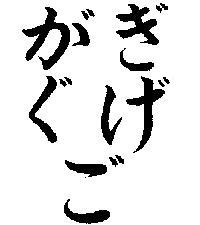 'Ga', 'Gi', 'Gu', 'Ge', 'Go'. This is the voiced counterpart of 'Ka', 'Ki', 'Ku', 'Ke', 'Ko'.
'Ga', 'Gi', 'Gu', 'Ge', 'Go'. This is the voiced counterpart of 'Ka', 'Ki', 'Ku', 'Ke', 'Ko'.
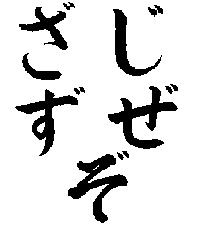 'Za', 'Ji', 'Zu', 'Ze', 'Zo'. The 'ji' is pronounced like 'gee'. This is the voiced counterpart of 'Sa', 'Shi', 'Su', 'Se', 'So'.
'Za', 'Ji', 'Zu', 'Ze', 'Zo'. The 'ji' is pronounced like 'gee'. This is the voiced counterpart of 'Sa', 'Shi', 'Su', 'Se', 'So'.
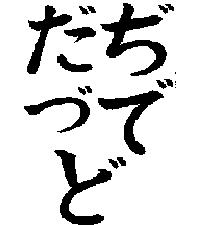 'Da', 'Ji', 'Zu', 'De', 'Do'. 'Ji' and 'Zu' are pronounced the same as above, but the 'Ji' and 'Zu' counterparts of 'Shi' and 'Su' are generally the one's that are used. This is the voiced counterpart of 'Ta', 'Chi', 'Tsu', 'Te', 'To'.
'Da', 'Ji', 'Zu', 'De', 'Do'. 'Ji' and 'Zu' are pronounced the same as above, but the 'Ji' and 'Zu' counterparts of 'Shi' and 'Su' are generally the one's that are used. This is the voiced counterpart of 'Ta', 'Chi', 'Tsu', 'Te', 'To'.
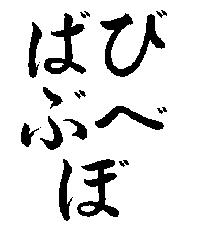 'Ba', 'Bi', 'Bu', 'Be', 'Bo'. This is the voiced counterpart of 'Ha', 'Hi', 'Fu', 'He', 'Ho'.
'Ba', 'Bi', 'Bu', 'Be', 'Bo'. This is the voiced counterpart of 'Ha', 'Hi', 'Fu', 'He', 'Ho'.
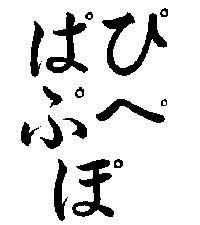 'Pa', 'Pi', 'Pu', 'Pe', 'Po'. This is the unvoiced counterpart of 'Ha', 'Hi', 'Fu', 'He', 'Ho'.
'Pa', 'Pi', 'Pu', 'Pe', 'Po'. This is the unvoiced counterpart of 'Ha', 'Hi', 'Fu', 'He', 'Ho'.
Well, that was quite a bit! It may look like a whole lot, but just take it one step at a time. Once you memorize these letters you can move on and learn more, because most likely I won't be typing this up in Roomaji. After all, you can't only learn the parts you happen to like, if you want to learn Japanese you're going to have to know the alphabet at some point.
This is quite a bit for one page, but my suggestion would be to make flashcards of about fifteen at a time. Don't only do that though, write them down. That will help you memorize them. As I said, they write horizontally first from top to bottom, then write the vertical lines from left to right. I can't do too much since this is only a webpage, but hopefully this is a good start.
If you wish to use these images please give me credit because they took a long time to make.
Go Back










 'Ga', 'Gi', 'Gu', 'Ge', 'Go'. This is the voiced counterpart of 'Ka', 'Ki', 'Ku', 'Ke', 'Ko'.
'Ga', 'Gi', 'Gu', 'Ge', 'Go'. This is the voiced counterpart of 'Ka', 'Ki', 'Ku', 'Ke', 'Ko'. 'Za', 'Ji', 'Zu', 'Ze', 'Zo'. The 'ji' is pronounced like 'gee'. This is the voiced counterpart of 'Sa', 'Shi', 'Su', 'Se', 'So'.
'Za', 'Ji', 'Zu', 'Ze', 'Zo'. The 'ji' is pronounced like 'gee'. This is the voiced counterpart of 'Sa', 'Shi', 'Su', 'Se', 'So'. 'Da', 'Ji', 'Zu', 'De', 'Do'. 'Ji' and 'Zu' are pronounced the same as above, but the 'Ji' and 'Zu' counterparts of 'Shi' and 'Su' are generally the one's that are used. This is the voiced counterpart of 'Ta', 'Chi', 'Tsu', 'Te', 'To'.
'Da', 'Ji', 'Zu', 'De', 'Do'. 'Ji' and 'Zu' are pronounced the same as above, but the 'Ji' and 'Zu' counterparts of 'Shi' and 'Su' are generally the one's that are used. This is the voiced counterpart of 'Ta', 'Chi', 'Tsu', 'Te', 'To'. 'Ba', 'Bi', 'Bu', 'Be', 'Bo'. This is the voiced counterpart of 'Ha', 'Hi', 'Fu', 'He', 'Ho'.
'Ba', 'Bi', 'Bu', 'Be', 'Bo'. This is the voiced counterpart of 'Ha', 'Hi', 'Fu', 'He', 'Ho'. 'Pa', 'Pi', 'Pu', 'Pe', 'Po'. This is the unvoiced counterpart of 'Ha', 'Hi', 'Fu', 'He', 'Ho'.
'Pa', 'Pi', 'Pu', 'Pe', 'Po'. This is the unvoiced counterpart of 'Ha', 'Hi', 'Fu', 'He', 'Ho'.